At one time, Chrysler had a very strong reputation for engineering. Nearly all of that reputation was the result of Walter Chrysler hiring three very talented engineers, and trusting them with many of the decisions that quickly catapulted Chrysler to number three in sales in a very short period. Fred Zeder, Owen Skelton, and Carl Breer, known as “The Three Musketeers,” were responsible for designing great cars with innovative features such as four wheel hydraulic brakes, downdraft carburetors, and rubber engine mounting (floating power). It was their foray into aerodynamics that lead them to their greatest engineering success, and most spectacular sales disaster, the Chrysler Airflow. One of the few survivors of this amazing line of futuristic automobiles, this 1934 Desoto Airflow is for sale on Craigslist, and is located in Ringgold, Georgia. Mostly in original condition, this aerodynamic game changer is being offered at $10,500.
When you look at the cars offered by American manufacturers that year, the Airflow, sold under both the Chrysler and Desoto nameplates, was far and away the most advanced in the field. Looking past the obvious aerodynamic advancements, a lot of work was done to provide a more comfortable ride for passengers. The engine was moved forward to the point that it was over the front axle. This allowed engineers to move the rear seat from above the rear axle, making the back seat a far less bumpy place to be. Furthermore, the construction of the body was all steel, a major advance from the metal over wood construction that nearly all manufacturers used. Built as a “unibody,” this advanced construction caused a lot of problems as workers got used to this new form of construction. From a safety and strength standpoint, it was well worth the trouble.
You have to feel for the Three Musketeers. As automobile engineers, they had hit a bases loaded homer. Unfortunately, the public did not warm to the design at all. Initial quality problems weren’t very helpful, and a ridiculous General Motors campaign to make consumers think the car wasn’t as safe as cars with traditional metal on wood construction hurt as well. To counter this, Chrysler filmed an Airflow being sent over a 110 foot cliff in Pennsylvania, and put the film in before the feature movie in theaters. To the amazement of viewers, a driver walked over to the car at the base of the cliff, opened the door, and drove it away. Still, production numbers stayed low, and the last of the Airflows were produced in 1937 before the plug was pulled. The influence the Airflow’s design had on Ferdinand Porsche and his Volkswagen “people’s car” is obvious.
While they were well built cars, you don’t see many Airflows at car shows anymore. People with the means often chose to restore more beautiful cars, and the costs to restore an Airflow are considerable. Add to that the difficulty in finding parts, and you can see why. However, the mechanical bits are still available through some aftermarket vendors. This particular Airflow looks to have all of the necessary parts, and they are in restorable condition. While there is surface rust, the pictures don’t show any spots where rust has eaten through the metal.
Inside, we see that the wooden floor, the only exception to the Airflow’s all metal construction other than the seat bottoms, is no longer there. Hopefully, there are patterns on the internet or in shop manuals to reproduce them. Otherwise, the lack of upholstery seems to be the only problem. That may end up being a rather pricey problem, as there isn’t that much of the original upholstery to make patterns from, and I would imagine that putting in a new headliner would require the skills of a very talented upholsterer.
Under the hood is the standard flathead six cylinder engine that powered many Chrysler products until 1960, and in industrial and agricultural engines until 1970. As you can see from the picture, the engine compartment was rather tight for a car of the 1930s, and mechanics must have loved to see them come in the garage for repair. At any rate, it looks like all of the hard to find bits are still there. We cannot see the air filter assembly, but these are usually removed to take pictures anyway. I’d just make sure it was still around, as it is probably a part special to Airflows.
Part of me wants to go and look at this car myself. I have always admired Airflows, and have lusted after the few straight eight coupes they made. Everything about them, from the solid construction, roll out windshields, and incredible ride, points to the makings for an incredible car for long distance tours. Sadly, I think the restoration costs would break me, but a trip to Wal-Mart does that on a weekly basis. I hope this one goes to an admirer who has the patience and skills to bring it back to showroom condition. People need to see Airflows and learn the story behind them. They are the ultimate “what if…” car. Can you imagine if the whole industry had to adopt the Airflow’s innovations in the mid thirties instead of the slow integration of these ideas that ended up happening?
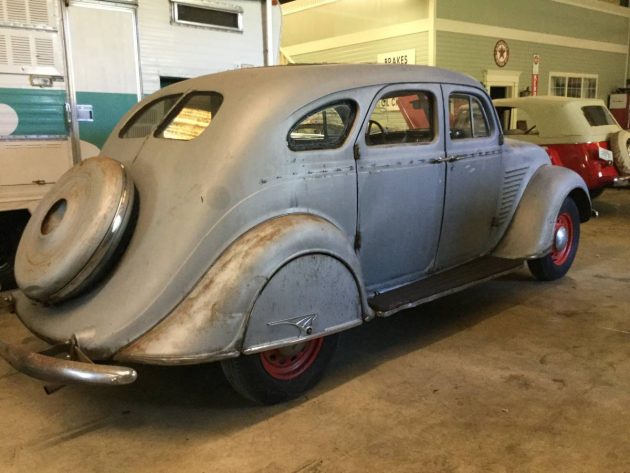
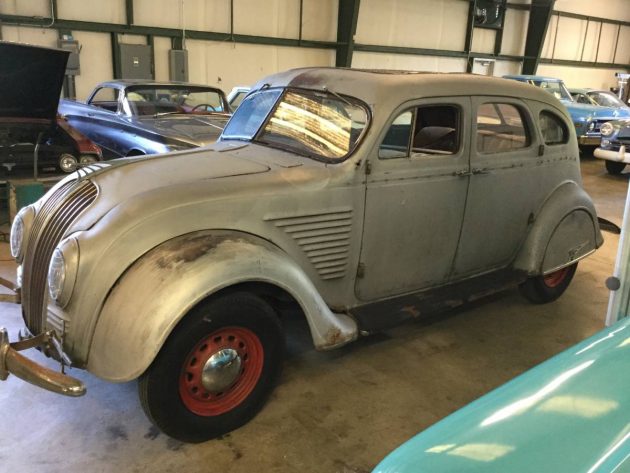
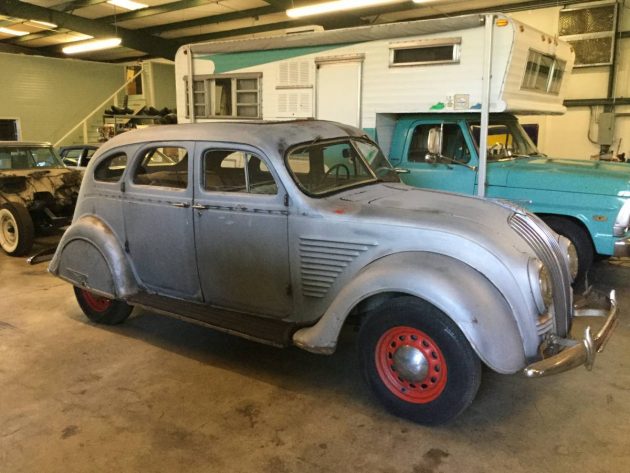
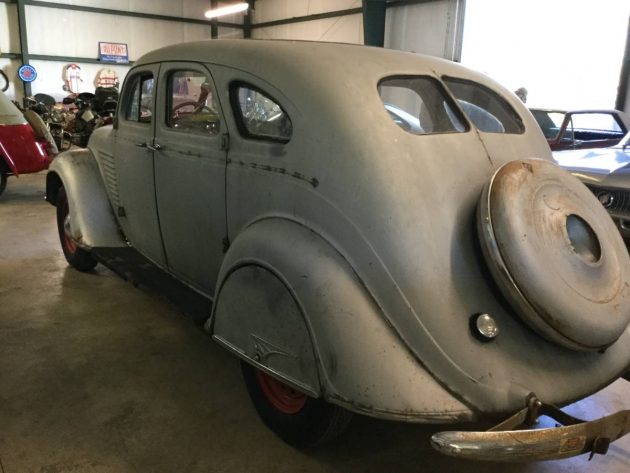

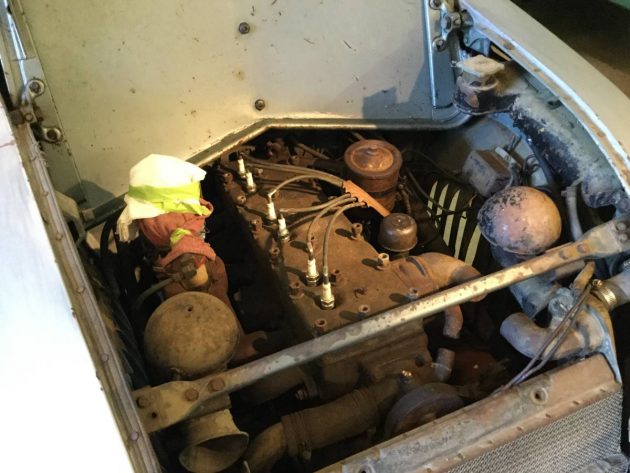


Nice car but, it needs a little more than I could do at the moment. However, I’d be happy the 1960 Buick in the background.
The interior shot certainly explains the Airflow name. But I joke. I love these cars. Was the design too European looking?
Can’t say I’m a fan but that body looks great from what I can tell. If it where mine I’m sure I’d do something inappropriate with it, looks too darn solid!
They flopped because they were considered ugly. I agree with my 1930s ancestors.
Almost a pedal-car, and the seats have built-in cooling. Is that a swivel seat in the back, or is my astigmatism doing its usual?
I’ve admired the AeroFlow’s for being so ahead of their time. Wish I had this one, and once done would be a fantastic parade car.
I’ve always loved the Airflows; truly ahead of their time. Even in this ‘needy’ condition the beauty shines thru.
Despite this one’s completeness, no doubt it will be a costly restore. It’d be great to see this one on the ‘other side’ of the restoration.
Hard work and skill could reduce the cost considerably, I think. Looks to me as if this would be a pretty straightforward resto, with the big hits coming from paint, upholstery and plating.
Restoration would be fully justified, even if not necessarily from a ROI standpoint. There aren’t that many left.
Personally, I’d rather have a Tatra 77, which to me outshone the Airflow in engineering and may well have had an influence on the Chrysler’s design, as it did on Dr Porsche’s KdF-wagen..
Kind of amazing that the VW Bug became such a ubiquitous icon, and this car was a financial flop. There’s so much similarity in their styling and timeframes… the big obvious difference is the nationality of their audiences. Sorry this one wasn’t a success — would’ve been interesting to see what a different path Chrysler design might’ve done if it’d been a hit.
Saw an ultra rare Chrysler Imperial Airflow at the car museum in Sacramento yesterday!
This is automotive history and innovation. If you are used to projects, buy this car, restore it, and drive it proudly.
wouldn’t mind the Ford truck with the camper , When I was a kid Mr Bean ( real name ) had one of these , I thought it was ugly , but also thought so was my Grandfathers Nash Ambassador air flyte , that is until we took a LONG trip in the Nash what a comfortable car ,even better than my dads Chrysler ( heard him tell Pa that )not an airflow .
I saw this one at Hemmings in August. The windows are so cool!
https://www.youtube.com/watch?v=b34gBJnNoQ4
The grlll area reminds me of a divco
Not attractive but at the same time nice. Hope someone buys it that can afford to bring it back to it’s former glory.
This purchaser obviously is in over his head for buying this but oh well. I’d rather have a fiberglass dune buggy or something more classic like that.
My Mother bought 37 acres of property in Upper Michigan in 1970. There was a black 1934 4-door Airflow body in the back field. No chassis, roof, engine, hood, grill, wheels, or spare tire. I played in it as Dad built a 150 vehicle junkyard around it. It was too big a project for him to tackle, so when I moved away for 5 years, he hauled it to the scrap yard. My biggest vehicular regret.